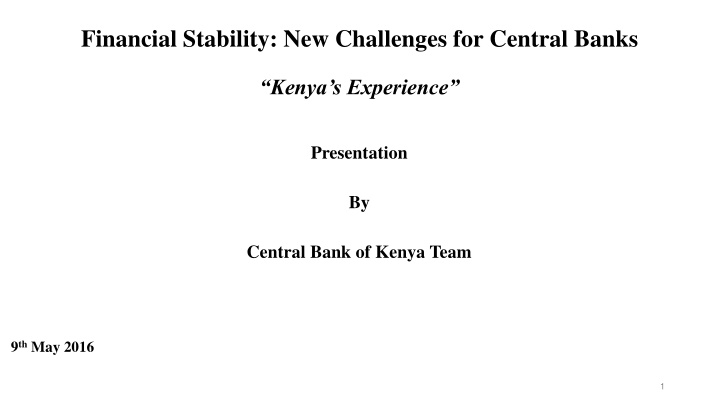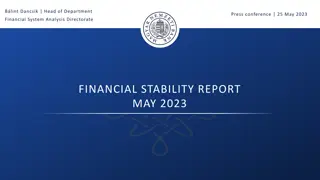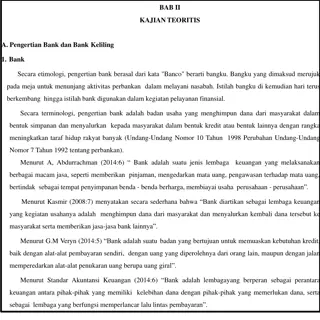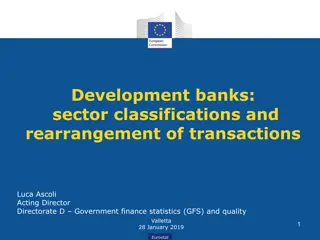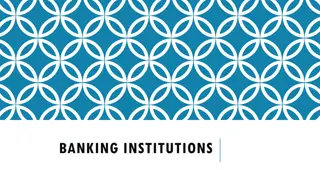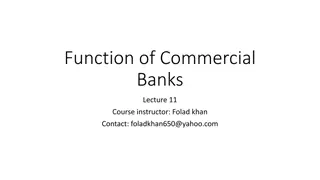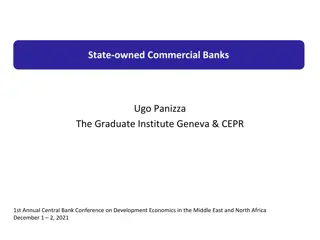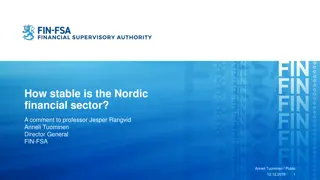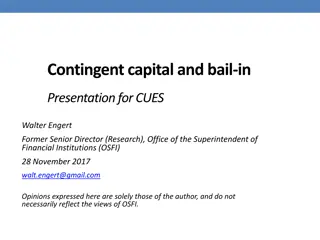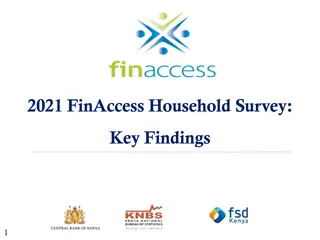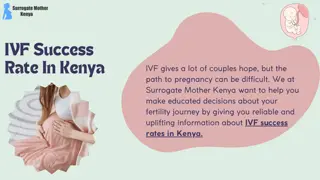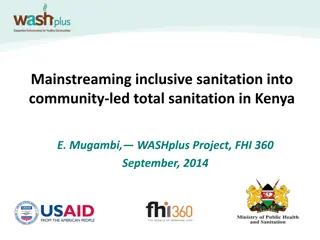Financial Stability Challenges for Central Banks: Kenya's Experience 2016
This presentation by the Central Bank of Kenya team on May 9, 2016, delves into the new challenges facing central banks in ensuring financial stability. It covers the structure and size of Kenya's financial system, the functions of the Central Bank of Kenya, institutional coordination, tools, and instruments, as well as the key challenges faced. The presentation also discusses the Central Bank of Kenya Act and its provisions for maintaining financial stability.
Download Presentation

Please find below an Image/Link to download the presentation.
The content on the website is provided AS IS for your information and personal use only. It may not be sold, licensed, or shared on other websites without obtaining consent from the author.If you encounter any issues during the download, it is possible that the publisher has removed the file from their server.
You are allowed to download the files provided on this website for personal or commercial use, subject to the condition that they are used lawfully. All files are the property of their respective owners.
The content on the website is provided AS IS for your information and personal use only. It may not be sold, licensed, or shared on other websites without obtaining consent from the author.
E N D
Presentation Transcript
Financial Stability: New Challenges for Central Banks Kenya s Experience Presentation By Central Bank of Kenya Team 9thMay 2016 1
Layout 1. Structure of Kenya's Financial System 2. Size of Kenya's Financial System 3. Financial Stability Function of the Central Bank of Kenya 4. Financial Stability Institutional Arrangement and Coordination 5. Macro and Micro -prudential Tools and Instruments 6. Challenges 2
1. STRUCTURE OF KENYAS FINANCIAL SYSTEM Parliament Parent Ministry (National Treasury, Agriculture, and Industrialization Saccos Societies Regulatory Authority Capital Markets Authority Central Bank of Kenya Retirement Benefits Authority Insurance Regulatory Authority KDIC Insurance Companies, Reinsurance Companies, Agents, Brokers, Claims Agents, Medical Insurance Providers, DFI s (AFC, KIE, KPOSB), Commissioner of Co- operatives (Non-Deposit Taking SACCOS s) Commercial Banks, Microfinance banks, Mortgage Companies, Foreign Exchange Bureaus, Credit Reference Bureaus, National Payments System NSSF, Pension Funds, Fund Managers, Administrators, Trustees Nairobi Securities Exchange, Investment Banks, Brokers, Investment Advisors, Custodians Savings and Credit Co-operative Societies (Sacco's) 3
2. Size of the Financial System Sector End December 2014 Assets in KSh Mns* 5,357,672 Assets as a % of GDP Number of Institutions n/a Nominal GDP 43 commercial banks; 1 mortgage finance company 9 Microfinance Banks Banks and Mortgage Firms 3,261,095 60.87 Microfinance Banks 56,900 1.06 17 administrators; 10 custodians 48 Insurance Companies; 3 Reinsurance Companies 181 Deposit Taking Saccos 29 Pension Funds plus NSSF fund managers; 750,040 14.00 Insurance Companies 426,310 7.96 Saccos 301,537 5.63 TOTAL ASSETS 4,795,882 89.52 Equities Market Cap. 2,300,000 42.93 * Convert into USD assuming KSH 90 = 1 USD 4
3. Central Bank of Kenya (CBK) Act provides for the financial stability mandate as follows:-- Fostering the liquidity, solvency and proper functioning of a stable market-based inclusive financial system Financial Stability Function of the Central Bank of Kenya The functional arrangement at CBK includes: Micro-prudential surveillance of the banking sector and other intermediaries under CBK oversight Oversight of the payments, settlement and clearing system Coordination of financial stability function including macro-prudential surveillance 5
4. Institutional Arrangement and Coordination of Financial Stability Function At the National Level: Bank Supervision Department Policy development and review of legal & regulatory frameworks Licensing of new institutions banks and representative offices, microfinance banks, CRBs, forex bureaus and money remittances and appraise new products and instruments Prudential supervision (on- & off- site surveillance) of license intermediaries Secretariat to the National Taskforce (NTF) on Anti-Money Laundering and Combating the Financing of Terrorism National, regional and international coordination and liaison role on micro-prudential matters Central Bank of Kenya Financial Stability Unit (FSU) with responsibility to: Adopt and implement macro-prudential policy framework Regularly conduct financial stability surveillance, assessment and analysis including developing tools and risk mitigation measures Carry out financial inclusion surveys and analysis using both demand and supply side and financial market conduct practices Coordinate national, regional and international initiatives on financial stability and financial inclusion issues Kenya Deposit Insurance Corporation (KDIC) and CBK on banking safety nets, and crisis management and resolution Financial Sector Regulators Forum (FSRF) to facilitate information sharing and collaboration in areas of mutual interest Members - CBK, CMA, IRA, RBA and SASRA with the National Treasury, Ministry of Industrialization and Enterprise Development, and KDIC as observer status 6
Institutional Arrangement and Coordination of financial stability function At the Regional Level: East African Community (EAC) Monetary Affairs Committee (MAC) EAC Central Banks signed MOU in 2008 for information sharing and supervisory cooperation on regional banking groups East African Monetary Union (EAMU) Protocol signed by Partner States in November 2013 among other things provides for promotion of a comprehensive, accurate and systematic assessment of financial stability EAC Monetary Affairs Committee (MAC) has a Banking Supervision and Financial Stability Sub-Committee that deals with banking supervision and financial stability issues. It is supported by three Working Groups Macro-prudential Statistics (MPS); Macro-prudential Analysis and Stress Testing (MAST) and Crisis Management (CM) to fast-track financial stability issues The Common Market for Eastern and Southern Africa (COMESA) The Financial Sector Development and Stability Sub-committee of the COMESA Monetary Institute to champion adoption and implementation of financial stability surveillance, assessment and analytical frameworks including risks identification, assessment and mitigation measures Association of African Central Bank s (AACB) Community of African Banking Supervisors (CABS) with the following working groups; Cross border supervision Crisis Management and Banking Crisis Resolution New Basel Core Principles 7
5. Kenya s banking system is becoming highly integrated in the domestic and global economies: Banks linked to telecoms, etc. (groups and conglomerates) Product innovations and delivery channels e.g. banks partnering with Insurance, Investment banks, agents (third parties to offer basic banking services) Currently there are 11 banks with cross-border operations Level of financial access in Kenya has improved with 75.3% of adult population accessing financial services from formal channels up from 26.7% in 2006. This calls for development and enhancement of appropriate prudential tools and instruments CBK is developing a Macro-prudential Policy Framework and fine-tuning the microprudential surveillance tools Focus of Macro-prudential tools and Instruments: Assessing systemic risks (time and cross sectional dimension) and enhancing resilience Facilitate financial stability surveillance and assessment. This requires; o Surveillance database and indicators {Financial Soundness Indicators (FSIs) and Early Warning Indicators (EWIs)} o Assessment and analytical tools e.g. Stress Testing frameworks, Risk Heat Map, Network Analysis, etc. Current initiatives include; o Capital Conservation buffers, o Leverage, Loan-to-Value (LTV), o Liquidity tools ( liquidity buffers for risk management ), o Forex exposure limits (10% NOP), limits on credit concentrations (top 50 borrowers), o Stress testing (micro & macro) using Cihak Framework Macro and Micro -Prudential Tools and Instruments 8
. Macro-& Micro- Tools and Instruments Micro-prudential surveillance and coordination as evidenced in: MoUs with supervisors of other jurisdictions Joint inspections for banking groups with regional presence Consolidated supervision to address inter-and intra-group relationships Supervisory college meetings for banks with regional presence to enhance understanding of their complex structures Mapping of Financial Institutions (FIs) groups and conglomerates and developing analytical and risk assessment (e.g. contagion, network analysis) frameworks to capture both sectoral and geographical dimensions 9
AML/CFT Initiatives In 2010, Kenya underwent Mutual Evaluation on AML/CFT issues under the Eastern and Southern Africa Anti-Money Laundering Group (ESAAMALG) The Financial Action Task Force on money laundering (FATF) recommended review of progress made by Kenya in addressing AML/CFT issues identified under ESAAMALG. The Regional Review Group report noted among others, the; Enactment of the AML/CFT Law and regulations Establishment of a Financial Reporting Centre (FRC) for coordination of implementation Political good will to drive the AML/CFT implementation process Kenya was removed from the FATF s monitoring process under the global AML/CFT compliance process in 2014. 10
6. Challenges Clarity of the financial stability and Macro- prudential Policy Mandate Legal and regulatory regime Institutional governance structures CBK, National Treasury and other Regulators Institutional coordination and policy framework Enhance regulatory perimeter and reduce/ eliminate regulatory arbitrage Existence of unregulated segments Interconnectedness (groups, conglomerates and cross- border issues) Shadow banking/ parallel banking Enhance FIs Governance and Integrity regimes Public confidence AML/CFT & financial flows Compliance with international standards IFRS Banking, insurance, pensions, capital markets and Financial Markets Infrastructures AML & CFT etc. Data quality/ gaps and surveillance arrangements Improve data coverage, scope, and integrity reporting form, frequency, Credibility and adequacy of data and data capture systems Data Capture Systems (database) and analytical framework Capacity constraints Staffing with appropriate skills set Capacity building Systems Effective coordination and collaboration at national, regional & international level Information sharing and reporting Financial stability assessment and analysis Safety nets, crisis management and resolutions Communications strategy 11
Thank You 12
